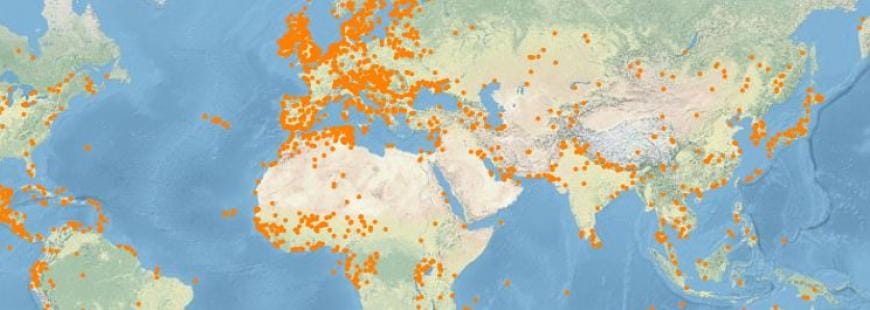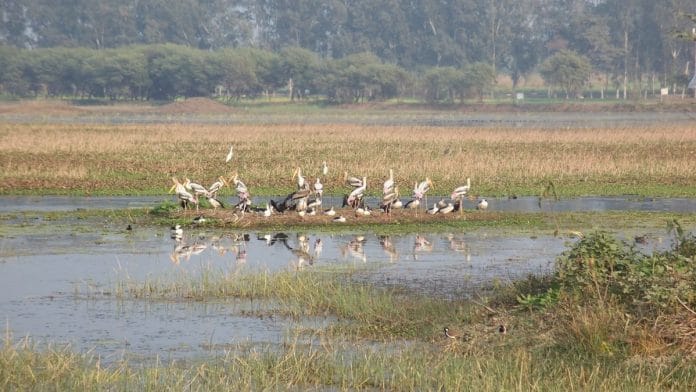Bengaluru: The Ministry of Environment, Forest and Climate Change (MoEFCC) announced earlier this week that 10 more wetlands from India have been added to the Ramsar list.
The Ramsar list identifies wetlands around the world that are important for global biological diversity and sustaining human life, and provides guidance on their proper management.
This initiative is governed by the Ramsar Convention on Wetlands, an intergovernmental treaty that provides a framework for the conservation and wise use of all wetlands through local and national actions and international cooperation. It was officially adopted in the 1970s in the Iranian town of Ramsar.
The new Ramsar sites of India are in three states — Uttar Pradesh (Nawabganj, Parvati Agra, Saman, Samaspur, Sandi and Sarsai Nawar), Maharashtra (Nandur Madhameshwar) and Punjab (Keshopur-Miani, Beas Conservation Reserve and Nangal).
This brings the total number of Ramsar sites in India to 37, with lakes such as the Chilika in Odisha and Kolleru in Andhra Pradesh, the Sundarbans area — which also happens to be located within one of the latest mangrove ecosystems in the world — and river sections like the Upper Ganga already in the list.

According to India State of Forest Report, 2019, released in December last year, the country has 62,466 wetlands covering 3.83 per cent of its recorded forest area.
“Wetlands comprise a whole range of ecosystems. Some like riverine ecosystems are natural… there are a lot of others like ponds and lakes that are built by humans for purposes like irrigation, supporting fisheries, etc. These also support biodiversity,” said Jagdish Krishnaswamy, a senior fellow at the Suri Sehgal Centre for Biodiversity and Conservation, Ashoka Trust for Research in Ecology and the Environment.
Krishnaswamy is the coordinating lead author of an IPCC special report on climate change, desertification, degradation, sustainable land management, food security, and greenhouse gas fluxes in terrestrial ecosystems.
“Then there are wetlands created by dams and barrages like the Asan Barrage in Uttarakhand and the Pong Dam (in Himachal Pradesh), which hosts one of the largest congregations of bar-headed geese,” he added.
Also read: Not only development work, Western Ghats face threat from plantations and agriculture too
Wetlands have most diverse ecosystems
Wetlands are a unique ecosystem flooded with water — permanently or seasonally — and serve as seasonal habitats for migratory birds. Apart from biological support, they also perform water purification functions, store nutrients and stabilise shorelines.
Most prominently, wetlands enable groundwater recharge and typically have the most diverse biological ecosystems, supporting a wide variety of plants, animals, fish, and various species of birds, especially local waterfowls. They also provide livelihood options for those engaged in fisheries.
Wetlands also face the most prominent environmental degradation. The largest wetland in the world is the Amazon river basin.
Krishnaswamy, who recently returned from the wetlands along the Beas Conservation Reserve, said the area is “an outstanding example of a riverine environment”. It has the Pong Dam, which is considered a sanctuary, upstream and the Harike barrage, which is also a Ramsar site, downstream.
The river stretch in between and associated riparian areas, he said, have now been recognised as a Ramsar site. “This is a very good cluster of wetlands.”
Ramsar status for this section of the Beas river is also important because it hosts the last remaining population of the Indus river dolphins. Today, there are only six or seven Indus river dolphins in India, making them the rarest mammal in the country.
Wetlands, especially estuarine ones (where the wide part of a river meets the sea) having mangrove cover, have very high carbon sequestration and storage capacities.
Urban wetlands also serve multiple functions. One unique role, Krishnaswamy pointed out, is how these wetlands filter waste through sediments and vegetation. The water that comes out of these wetlands can be treated with minimal costs and reused for human consumption.
Also read: Water bodies running dry at alarming rate due to groundwater depletion, reveals study
Protecting India’s existing wetlands
T.V. Ramachandra of the Energy & Wetlands Research Group, Centre for Ecological Sciences, Indian Institute of Science (IISc), said it was “nice to see so many (wetlands) joining the Ramsar list”. “The Aghanashini estuary (in Karnataka) still awaits this decision.”
He was referring to a proposal made by the Energy and Wetlands Research Group to the MoEFCC in February 2019 to declare the estuary a Ramsar wetland.
The Aghanashini river joins the Arabian Sea in a village called Aghanashini in the Uttara Kannada district of Karnataka and forms an estuary that, given its “flourishing mangrove vegetation, its rich birdlife and traditional way of life of the people” needs to be protected as a cultural heritage, the proposal declares.
The Ramsar recognition, among other things, acts as an international obligation, much like the ‘World Heritage Site’ tag provided by UNESCO that obligates regional and state governments to look after these sites.
Once made part of the Ramsar list, the sites also garner attention from civil society groups, conservationists and academics.
Krishnaswamy explained how all aspects of the Beas ecosystem such as water released from the Pong Dam, amount of sediment deposited, etc will now be monitored more closely because of its inclusion in the Ramsar list.
Apart from recognising new Ramsar sites, there is also a need to thoroughly conserve the ones already on the list.
“Dumping of solid waste has become a major threat to the wetland ecosystems in the country,” Krishnaswamy added.
Ranjan Panda, convenor of Water Initiatives in Odisha, said while it was important to notify and conserve Ramsar sites, India also “needs to recognise the importance of all forms of ‘water commons’ like water bodies, swamps, bogs, marshes, deltas and floodplains. Many such areas are currently under threat from encroachment and pollution”.
Thorough policy measures to conserve water commons would “help increase our water harvesting potential, and improve (the) groundwater (situation)”, Panda added.
Rishika Pardikar is a freelance journalist based in Bengaluru.
Also read: This man-made disaster is under your feet — shrinking river flows dry up the ground






